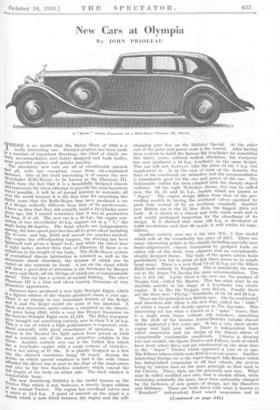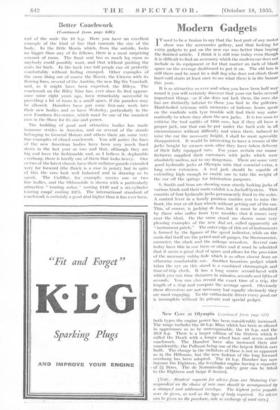New Cars at Olympia
BY JOHN PRIOLEAU
A " Barker " Saloon limousine on a Roils•Royee Phantom 111. Chassis
THERE is no doubt that the Motor Show of 1986 is a really interesting one. Decided progress has been made la a number of important directions, 'the chief of which are "lore accommodation and.better designed and .built bodies, "tore powerful engines and quieter running. The absolutely new cars are all- of considerable interest !ad all with one exception, come from old-established actories. One of the most interesting is of course the new 1,,2-cylinder Rolls-Royce, to be known as the Phantom III. Apart from the fact that it is a beautifully 'designed chassis d represents the latest attempt to provide the most luxurious 'ravel possible, it will be of special interest, to motorists all over the world because it is the first time for something like thirty years that the Rolls-Royce firm have, produced a car a design radically different from that a its predecessors. I have an idea that they did actually build a 12-cylinder some Years ago, but I cannot remember that it was in prOduction pr long, if at all. The new car is a 50 h.p., the engine con- sisting of two six-cylinder 25-h.p. engines set in a V," the angle being 60 degrees. The front • wheels are independently SPrung, the four-speed gear box has all its gears silent including ;lite reverse, and top, third, and second are synchro-meshed. engine has self-adjusting tappets, the steering has been lightened and given a 'larger lock, and while the wheel base is eight inches shorter than that of Phantom II there is no reduction in the length of the body. The Rolls-Royee system 0 centralised chassis lubrication is retained as well as the automatic shock absorbers, the tension of which can be varied at any moment by hand., A car on the stand which will draw a good deal of attention is the limousine by Hooper la grey and black, all the fittings of which are of untarnishable This car has a system of central heating. The other Phantom III is a blue and silver touring limousine of very attractive appearance, . Daimlers have produced a new light Straight Eight, which a lighter edition of the chassis produced about a year ago. it-ere is no change in any important feature of the design ci it and the larger model are more or less identical. A 21ack and chromium sports saloon is mounted on the chassis, the price. being £905, while a very tine Hooper limousine on the heavier Straight Eight costs £1,510. The Riley Company have brought out something entirely new in their' V-8 18 "pas is a ear of which a high performance is expected, com- puted naturally with great smoothness of operation. It is shown in the Kestrel Six light saloon form priced at £450 and is certainly one of the most attractive exhibits in the Another entirely new car is the Talbot Ten which has -a 4-cylinder engine with a cubic content' of 1184.5c.c. all(' a tax rating of £7 10s. It is plainly designed as a fast ear, the claimed maximum being 70 m.p.h. Among the Points on which special emphasis is laid is the wide vision afforded the driver due in part to' the slope of the wind-screen !Ad also to the two .frameless windows which extend the 'all length of the body on either side. The back window is comfortably large. The new Armstrong Siddeley is the model known as the Twelve Plus which is not, however, a merely larger edition of the normal Twelve. The engine has overhead valves and is rated at 13.8 h.p. A point of interest on the stand is a Clutch which is now fitted between the engine and the self- changing gear box on the Siddeley Special. At the other end of the price and: power scale is the Jowett. After having been content to build the famous fiat 2-cylinder for something like thirty years, Without radical alteration, the Company has now produced gi 10 h.p. 4-cylinder on the same design. • This ear will not, however, take the place of the 7 h.p. but supplethent it. As in the case of Most of the Jowetts, the lines of the coachwork are attractive and time accommodation is remarkably good for the size and power of the ear. The fashionable outline has been adopted with the sharply sloped radiator., Of' the eight Wolseleys shown, five can be called new, the 10, 21 and 25 h.p.,'Tmodela which are known as " Super." The engine design differs from that of the pre- ceeding models in having the overhead valves operated by push rods instead of by an -overhang camshaft. Another new British ear is the 3i litre Alvis, the biggest Alvis yet built. It is shown as a chassis and with coach work and is well worth prolonged inspection for the cleanliness of its design. It is claimed that some 100 h.p. is developed at 3,600 revolutions and that 90 m.p.h. is well within its capa- bilities. Another entirely new ear is the new M.G. 2 litre model which sells at the remarkably low price of 1375. There are many interesting points in the chassis, including specially easy brake-adjustment, chassis lubrication by .grouped leads on either side of the daSh, twin, silencers and an exceptionally stoutly designed frame. The body of the sports saloon looks particularly low but in point of fact there seems to be ample head room. There is a new Ford V8 of 22 h.p. (at the Albert Hall) built entirely in England. This is practically the same car as the larger Va, having the same accommodation. The tax is £16 10s. Lastly there is the new car, the product of ' Trojan, Ltd., called the Mhstra. This has what must be an absolute novelty in, the shape of a 6-cylinder two stroke engine. It is, ,like the Trojans, rear driven. Finally there are the three new "Flying," Standards, of 12, 16 and 20 h.p. These are the principal new British cars. On the continental and American side, there is the new Fiat, called the " 1500," of which a report will shortly appear in The Spectator. This interesting ear has what is known as a " spine " ftame, that is a single main frame without side members, something in the style of the famous Austro-Daimler tubular chassis which appeared a few years ago. It has a very short stroke engine and high gear ratio. There is independent front wheel suspension and the design of the chassis allows of exceptionally comfortable coachwork. Citroen is showing two new models, the Sports Twelve and Fifteen, both of which have front wheel drive and are constructed on the same lines as the " Super " Twelve' which appeared a year or so ago. The Fifteen saloon which costs £345 is a seven-seater. Another interesting foreign car is the super-charged Alfa-Romeo which has independent suspension to all four wheels, the system being by torsion bars on the same principle as that used in the Citroen. These, then, arc the genuinely new cars. What may be called modified new cars, that is models which, while remaining nominally the same, have been noticeably changed by the inclusion of new points of design, are the Humbers and Hillmans. These are both fitted with what is known as " Evenkeel " independent front wheel suspension and in
(Continued on page 642)
New Cers at Olympia (continued from page 633) both types the engine power has been considerably increased. The range includes. the 10 h.p. Minx which has been so altered in appearance as to be unrecognisable, the 18 h.p. and the 20.9 h.p. There is a larger edition of the Sixteen which is called the Hawk with a. longer wheel base and seven seated coachwork. The Humber have also increased their size considerably, the Pullman being one of the largest British ears built. The change in the radiators of these is not so apparent as in the Hillmans, but the new fashion of the long forward overhang has been adopted. The 10 h.p. Humber has now beporrie the Eighteen, the 0-cylinder engine having a capacity . uf. 2i litres. The de Normanville safety gear can be fitted to the Eighteen and Snipe if desired.
[Note. Readers' requests for advice from our Motoring Cor- respondent on the choice of new cars should be accompanied by a stamped slid addressed envelope. The highest price payable mos be given, as well as the type of body required, No advice can be given on the purchase, sale or exchange of used cars.]



























































 Previous page
Previous page